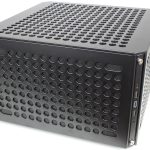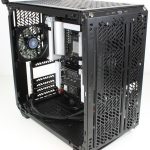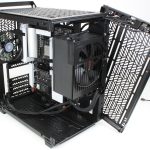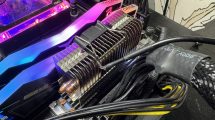Installation report
Just out of interest, I simply had to test several of the possible setups of the QUBE 500 in this review. Unfortunately, there wasn’t enough time for all of them and I also didn’t realize until too late that using an SFX power supply might have been smarter, but let’s get started first.
Test Bench Mode
The first thing to test was of course the Test-Bench Mode!
The feet are simply clicked into place:
The power supply mount is only pushed into the guide and later fixed with a screw.
Cool: The front I/O can be unscrewed from the front panel and attached to the base plate. The spacers must be used here urgently, otherwise there is a risk of short-circuits!
However, a simple cover would not only have been visually advantageous at this point.
The motherboard is allowed to take its place. CPU, NVME and RAM were already installed beforehand, whereas the “subsequent” installation wouldn’t have been more difficult in this case now.
The PSU was mounted at the highest possible position so that the long graphics card would still fit into the primary PCIE slot in the end.
Fits!
However, the QUBE 500 in this minimal configuration does not offer a mounting option for the graphics card, which therefore tilts a bit and rests on the heatsink of the chipset on the motherboard. Also, the AIO cannot be screwed anywhere, which is why I installed the large Dark Rock 4 from BeQuiet! for the test run.
Because the installation situation of the graphics card seemed too wobbly, I also screwed on the back panel. Apart from the graphics card, no other parts had to be removed.
This way, everything already makes a much more stable impression!
Test run – system works perfectly. I didn’t find the temperatures of the open setup that representative, which is why I didn’t perform any tests in this configuration.
HAF XB Mode
Now I wanted to know. Does the system have to be disassembled again, or can the other components just be bolted on to rebuild the case? The power supply cables for the graphics card had to be removed from the support surface for the front panel, of course, as well as the front I/O.
And indeed, all side panels could then be attached without further ado. Once the construction is complete, the stability of the case is not inferior to a regular case!
Due to the symmetrical construction, both the steel and the glass side panel can be used as a lid.
Regular Mid-Tower
We change the position of the feet from the base to the bottom part and in no time we have built a regular mid-tower out of the lying case. The fat CPU cooler has enough space up to the side panel, the graphics card can breathe freely, and plenty of fans could still be mounted under the PSU and in the bottom for fresh air.
Now, of course, the installation options for the AIO had to be tested.
This mode would have been ideal for the combination of a large power supply and a long graphics card, because everything would have fit at once. However, only the open side panel can be used as a cover, because the AIO wouldn’t get any air through the glass panel.
The lower position can be tight for wide graphics cards, otherwise the same applies as for the upper position.
Positioning the AIO in the bottom would have sucked in fresh air, but then the hoses and the graphics card would have gotten in the way. So I decided to mount the AIO in the lid. It probably would have just fit, but I wanted to be on the safe side and put the PSU one floor lower. To do this, simply remove the front with a few screws, loosen the PSU screw, unhook the PSU and hook it back in one notch further down, fix it in place and screw the front back on.
Only after installing the AIO did I notice that the freshly painted 3070 Ti would now not fit horizontally or vertically because of the large PSU. Crap!
Because I was too tight on time, I installed the small 4060 without further ado.
Also for cable management was accordingly little time left and also the photo with the folding ruler had to give way to the lack of time. Therefore, here is the info: behind the motherboard are 29-32mm space for cable management and thus the QUBE 500 shows itself benevolent, if you have to save some time at this point or are just lazy.
Close the lid, done!
Test run successful:
































































12 Antworten
Kommentar
Lade neue Kommentare
Urgestein
Mitglied
Urgestein
Veteran
Urgestein
Urgestein
Urgestein
Mitglied
Veteran
Neuling
Moderator
Neuling
Alle Kommentare lesen unter igor´sLAB Community →